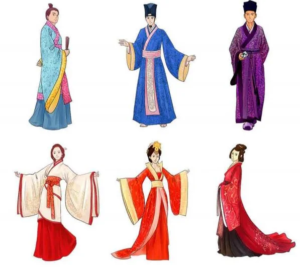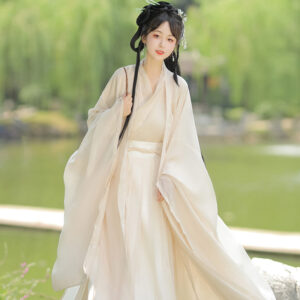
Headwear in Hanfu culture played a significant role, reflecting the wearer’s gender, social status, and occasion. Here are some of the common headwear styles associated with Hanfu:
1. Guan (冠)
- Description: The guan is a traditional crown or hat worn primarily by men, especially during formal occasions. It symbolizes authority and social rank.
- Types:
- Xiezhi Guan: Worn by law enforcement officials, featuring designs that signify justice.
- Gaoshan Guan: A square-shaped crown worn by high-ranking officials or those who introduced foreign guests.
2. Mao (帽)
- Description: This term refers to various types of hats, often made from fabric or silk. They were commonly worn by both men and women.
- Common Variants:
- Futou (幞头): A simple blue or black hat that became popular during the Sui and Tang Dynasties.
- Gauze Hat (纱帽): A lightweight hat often worn for protection against the sun.
3. Jin (巾)
- Description: The jin refers to kerchiefs or scarves used to cover the head. These were particularly popular among men and served both practical and ceremonial purposes.
- Types:
- Black Silk Ribbon Scarf (纶巾): A common style that was functional and elegant.
- Net Kerchief (网巾): Often used for more formal occasions.
4. Hairpins (簪)
- Description: Hairpins were essential accessories for women, used to secure hairstyles. They varied from simple designs to ornate pieces adorned with jewels.
- Symbolism: Hairpins often signified key life events, such as marriage, and could indicate social status based on their material (gold, silver, jade).
5. Headbands
- Description: Typically made of silk, headbands were used by both genders to keep hair neatly arranged.
- Marital Status Indicators: Specific patterns on headbands could indicate whether an individual was married or single.
6. Phoenix Crown (凤冠)
- Description: Worn by empresses, this ornate crown features phoenix decorations and is often made from gold and adorned with pearls and jewels.
- Symbolism: The phoenix represents grace and beauty, making it a fitting adornment for imperial women.
7. Lotus Crown (莲花冠)
- Description: Made of gold and jade, this crown was popular in the Tang Dynasty and often adorned with jewels.
- Cultural Significance: The lotus symbolizes purity and enlightenment in Chinese culture.
Conclusion
The headwear styles associated with Hanfu are not merely decorative; they carry deep cultural meanings that reflect social hierarchies, personal virtues, and historical traditions. Each piece of headwear tells a story about the wearer’s identity, status, and cultural heritage, making it an integral part of Hanfu attire throughout Chinese history.
Share this post
Facebook
Twitter
LinkedIn
Pinterest
Recent Posts


What were the key features of Hanfu during the Tang Dynasty?
October 24, 2024

How did Hanfu styles vary during different Chinese dynasties?
October 24, 2024

What accessories are typically worn with Hanfu?
October 24, 2024

How do you choose the right Hanfu for different seasons?
October 24, 2024

Newsletter
Subscribe for our monthly newsletter to stay updated
Popular Categories
Related Post
Sed aliquam, tortor et sodales malesuada, lorem leo luctus tellus, quis interdum eros nibh in nunc. Cras dignissim malesuada, lorem leo luctus

What are the winter hanfu called?
October 24, 2024

What were the key features of Hanfu during the Tang Dynasty?
October 24, 2024

How did Hanfu styles vary during different Chinese dynasties?
October 24, 2024

What accessories are typically worn with Hanfu?
October 24, 2024

